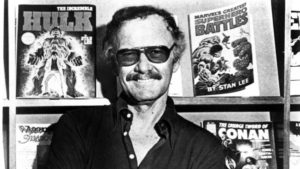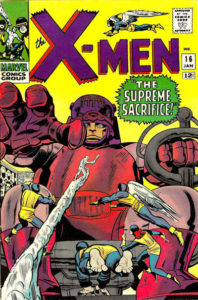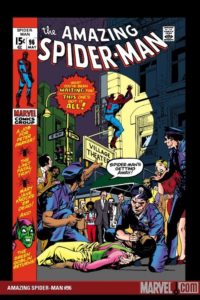
Once upon a time, comic books were a part of every kid’s existence. They were cheap, available everywhere, and were irresistible. Their themes ranged from war to horror to comedy to romance to their biggest attraction: superheroes.
The list of famous names behind the scenes at comic book publishers is a short one. DC comics, purveyors of Superman, Batman, and the rest of the members of the Justice League of America, was largely a faceless corporate entity. I can’t recall a single name that jumps out at me, despite reading hundreds of editions of their products.
But when you’re talking Marvel comics, two names stand tall. One is Jack Kirby, artist/editor who will likely rate his own column here in the future. The second is Stan Lee, creator of a huge number of superheroes whose names have become as familiar to us as our own.
Stanley Lieber was born on December 28, 1922 in New York City. His parents were Jewish immigrants from Romania. Stanley loved reading as a child, and by his teenaged years had found a talent for writing as well. He made a few bucks writing obituaries for a press service and press releases for the National Tuberculosis Center. He also took on whatever other odd jobs he could find, helping out his family’s Depression-ravaged situation.
In 1939, Stanley garnered a gig working for Timely Comics as an assistant. His duties were mundane, keeping inkwells full, picking up lunch, that sort of thing. But in 1941, he got his first big break. He was allowed to write up text filler for issue #3 of Captain America Comics. He used the pseudonym Stan Lee for the first time. His employers were impressed with his work. He was soon given a storyline of his own with a backup feature, “‘Headline’ Hunter, Foreign Correspondent.” You should remember those backup stories, one- or two-page tales that would fill out the comic.
As Stan stretched his creative wings, he was given more opportunities to use his imagination. He soon came up with new superheroes Jack Frost and Father Time. Late in 1941, he was promoted to interim editor following the departure of Jack Kirby and editor Joe Simon.
Again, Stan showed savvy in his new duties. However, Pearl Harbor caused a major change in his plans and he enlisted in the army. His commission was a literary one, as he stayed stateside and produced manuals, slogans, cartoons, and training films.

After the war, Lee went back to work for Timely. In 1950, they changed their name to Atlas Comics. Lee wrote stories in every genre that Atlas produced, covering the full scale from romance to cowboy tales. But Stan craved more serious literary work, and considered leaving comics altogether.
In 1961, Atlas changed their name again to Marvel Comics. Lee was charged with coming up with new superheroes that would compete with DC’s recent flood of new faces. He responded by coming up with The Fantastic Four, co-created by Jack Kirby, who had returned to the fold. Issue #1 was released in November of that year.
But he had only begun. Within a couple of years, he created with Kirby Thor, The X-Men, Iron man, The Incredible Hulk, and Spider-Man. He also created Daredevil and Dr. Strange with the collaberation of others.
Lee’s superheroes were some seriously flawed humans. They had issues that DC’s lineup, with the eventual exception of tortured Bruce Wayne, didn’t exhibit. They got ill, squabbled among themselves, had to scramble to get bills paid, and sometimes acted in quite antisocial ways.
Comics were entering their golden age, the 60’s and 70’s, when their popularity would reach heights that were unsurpassed before or after. This was our time. Thus, we all remember well-worn copies of comic books laying around our rooms which were read over and over. And Lee’s genius is responsible for many of the superheroes whose exploits we eagerly followed.

Lee the innovator also took on the Comics Code Authority, which was formed to reign in increasingly violent and sexual themes that were blossoming in the 50’s. In 1971, a three-part storyline of Spider-Man was set to be published in which Peter Parker comes to the aid of a friend who had gotten addicted to pills. The CCA said no, and Lee went ahead and published the stories without the familiar seal at the top of the front page. He ended up forcing them to lighten up their standards, and they henceforth allowed drug use to be portrayed in a negative light.
Lee became the public face behind Marvel in the 70’s. In 2001, he took on a gig at rival DC to create theirJust Imagine series, which rewrote the life stories of familiar DC heroes.
As he has gotten older, Lee has stayed busy and creative. He usually has a cameo role in any Marvel-superhero-based film, and there have been a slew of those lately. He’s been involved in producing direct-to-DVD films about new heroes. And he’s currently hosting a fascinating History Channel series called Stan Lee’s Superhumans, which focuses on people with remarkable physical abilities.
Here’s hoping this creative genius stays active and busy for many more years. Stan Lee is a big part of our collective Boomer memories.